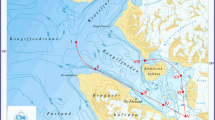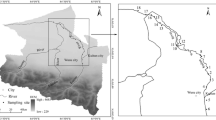Abstract
This study vividly presents results from a seasonal particulate matter measurement campaign conducted at world’s largest ship-breaking yard i.e., Alang-Sosiya (Gujarat, India) at six locations and a reference station at Gopnath which is 30 km south of this ship-breaking yard. The collected suspended particulate matter (SPM) 24-h samples were critically analyzed for heavy metals (Pb, Cd, Co, Ni, Cr, Mn, Fe, Cu, Zn). The average concentration of SPM within the ship-breaking yard during the investigation was 287.5 ± 20.4 μg m−3 and at reference station it was 111.13 ± 5.81 μg m−3. These values are found to be in excess of the permitted national standards. The levels of heavy metals at Alang-Sosiya are very high as compared to US EPA and WHO guidelines. The mean concentrations of all metals are in the order: Fe >>Zn >Cu > Mn > Cd >Pb > Co >Ni >Cr. The results on enrichment factors (EF) suggest that most of the metals in the ship-breaking yard exhibit EF values of near or above 100 which must have been comprehensively affected by ship-breaking activities. Metal data was used to evaluate the role of spatial factors on their distribution characteristics. Thereafter, factor analysis was carried out to identify the main components liable for the variance of the data set.
Similar content being viewed by others
References
Aage, B. A. (2001). Worker safety in the ship-breaking industries (pp. 30–31). Geneva: International Labour Office.
Bagiroz, O. (2002). Sulfate dry deposition in Izmi. MS thesis, Graduate School of Natural and Applied Sciences. Izmir, Turkey: Dokuz Eylul University.
Balachandran, S., Meena, B. R., & Khillare, P. S. (2000). Particle size distribution and its elemental composition in the ambient air of Delhi. Environment International, 26, 49–54.
Bilos, C., Colombo, J. C., Skorupka, C. N., & Rodriguez, P. M. J. (2001). Sources, distribution and variability of airborne trace metals in La Plata City area, Argentina. Environmental Pollution, 111, 149–158.
Bozlaker, A. (2002). Trace metals in airborne particles and their dry deposition in Izmir. MS thesis, Graduate School of Natural And Applied Sciences. Izmir, Turkey: Dokuz Eylul University.
Central Pollution Control Board (1994). National ambient air quality standards.
Chakraborti, D., Van Vaeck, L.,Van Espen, P. (1984). Calcutta pollutants. Part 2. Polynuclear aromatic hydrocarbons and some metal concentrations on air particulates during winter. International Journal of Analytical Chemistry, 88(32), 109–120.
Chester, R., Nimmo, M., & Preston, M. R. (1999). The trace metal chemistry of atmospheric dry deposition samples collected at Cap Ferrat: A coastal site in the western Mediterranean. Marine Chemistry, 68, 15–30.
Derek, E. (2004). Impacts and challenges of a large coastal industry Alang-Sosiya ship-breaking yard Gujarat, India. UNESCO report on environment and development in coastal regions and in small islands (pp. 16–17). France: UNESCO.
Dockery, D. W., Pope, C. A., Xu, X., Spengler, J. D., Ware, J. H., Ferris, B. G. et al. (1993). Mortality risks of air pollution: A prospective cohort study New England. Journal of Medicine, 329, 1753–1759.
European Commission (EC) Position Paper (2000). Ambient air pollution by As, Cd and Ni compounds. Working group on As, Cd and Ni compounds, DG Environ. 361.
Fang, M., Zheng, M., Wang, F., Chim, K. S., & Kot, S. C. (1999). The long-range transport of aerosols from northern China to Hong Kong — A multi-technique study. Atmospheric Environment, 33, 1803–1817.
Ferin, J., Oberd orster, G., Soderholm, S. C., & Gelein, R. (1991). Pulmonary tissue access of ultrafine particles. Journal of Aerosol Medicine, 4, 57–68.
Fidalgo, M. R., Mateos, J., & Garmendia, J. (1988). The origin of some of the elements contained in the aerosols of Salamanca (Spain). Atmospheric Environment, 22, 1495–1498.
Harrison, R. M., & Sturges, T. W. (1996). The measurement and interpretation of Br/Pb ratios in airborne particles. Atmospheric Environment, 17, 311–328.
Henry, R. C., Lewis, C. W., Hopke, P. K., & Williamson, H. J. (1984). Review of receptor model fundamentals. Atmospheric Environment, 18, 1507–1515.
Heyder, J., Brand, P., Heinrich, J., Peters, A., Scheuh, G., Tuch, T. et al. (1996). Size distribution of ambient particles and its relevance to human health. Presented at the second colloquium on particulate air pollution and health, Park City, Utah, 1–3 May, 1996.
Hopke, P. K. (2000). Workbook on data analysis. Prepared for participants in the UNDP/RCA/IAEA, subproject on air pollution and its trends, RAS/97/030/A/01/18, IAEA, Vienna, Austria.
Kulshrestha, U. C., Rao, N. T., Azhaguvel, S., & Kulshrestha, M. J. (2004). Emissions and accumulation of metals in the atmosphere due to crackers and sparkles during Diwali festival in India. Atmospheric Environment, 38, 4421–4425.
Kulshrestha, U. C., Saxena, A., Kumar, N., Kumar, K. M., & Srivastava, S. S. (1994). Measurement of heavy metals in the ambient air of Agra. Indian Journal of Environmental Protection, 685–687.
Lantzy, R. J., & Mackenzie, F. T. (1979). Atmospheric trace metals: Global cycles and assessment of man’s impact. Geochimica Et Cosmochimica Acta, 43, 511–525.
Li, N., Kim, S., Wang, M., Froines, J., Sioutas, C., & Nel, E. (2002). Use of a stratified oxidative stress model to study the biological effects of ambient concentrated and diesel exhaust particulate matter. Inhalation Toxicology, 14, 459–486.
Li, N., Sioutas, C., Cho, A., Schmitz, D., Misra, C., Sempf, J. et al. (2003). Ultrafine particulate pollutants induce oxidative stress and mitochondrial damage. Environmental Health Perspectives, 111, 455–460.
Lioy, P. J., Zelenka, M. P., Cheng, M. D., Reiss, N. M., & Wilson, W. E. (1989). The effect of sampling duration on the ability to resolve source types using factor analysis. Atmospheric Environment, 23, 239–254.
Odabasi, M., Sofuoglu, A., Vardar, N., Tasdemir, Y., & Holsen, T. M. (1999). Measurement of dry deposition and air–water exchange of polyaromatic hydrocarbons with the water surface sampler. Environmental Science and Technology, 33, 426–434.
Peters, A., Dockery, D. W., Heinrich, J., & Wichmann, H. E. (1997). Short-term effects of particulate air pollution on respiratory morbidity in asthmatic children. European Respiratory Journal, 10, 872–879.
Pitts Jr., J. N., & Finlayson-Pitts, B. J. (2000). Chemistry of the upper and lower atmosphere: Theory, experiments and applications. Florida, New York: Academic.
Ragosta, M., Caggiano, R., D’emilio, M., & Macchiato, M. (2002). Source origin and parameters influencing levels of heavy metals in TSP, in an industrial background area of southern Italy. Atmospheric Environment, 36, 3071–3087.
Sharma, V. K., & Patil, R. S. (1992). Chemical composition and source identification of Bombay aerosol. Environmental Technology, 13, 1043–1052.
Smith, D. J. T., Harrison, M., Luhana, L., Casimiro, A. P., Castro, I. M., Tariq, M. N. et al. (1996). Concentrations of particulate airborne polycyclic aromatic hydrocarbons and metals collected in Lahore, Pakistan. Atmospheric Environment, 30, 4031–4040.
Sweet, C. W., Vermette, S. J., & Landsberg, S. (1993). Sources of toxic trace elements in a urban air in Illinois. Environmental Science and Technology, 27, 2502–2510.
Taylor, S. R., & McLennan, S. M. (1985). The continental crust: Its composition and evolution (p. 312). Cambridge, Massachusetts: Blackwell Science.
Tripathi, R. M., Kumar, A. V., Manikandan, S. T., Bhalke, S., Mahadevan, T. N., & Puranik, V. D. (2004). Vertical distribution of atmospheric trace metals and their sources at Mumbai, India. Atmospheric Environment, 38, 135–146.
U.S. Environmental Protection Agency (1999). Air quality criteria for particulate matter, Vol. 1. Washington, District of Columbia: U.S. EPA Office of Research and Development. EPA/600/P-65/001aF.
U.S. Environmental Protection Agency (2001). Air quality criteria for particulate matter, Vol. 1. Washington, District of Columbia: U.S. EPA Office of Research and Development. EPA/600/P-65/001aF.
Van Borm, W. A., Adams, F. C., & Maenhaut, W. (1989). Characterization of individual particles in the Antwerp aerosol. Atmospheric Environment, 23, 1139–1151.
Voutsa, D., & Samara, C. (1996). Trace elements in vegetables grown in an industrial area in relation to soil and air particulate matter. Environmental Pollution, 94, 325–335.
WHO Air Quality Guidelines for Europe (2000). WHO regional publications Eur Ser No. 91. Copenhagen, Denmark: Regional office for Europe.
Yi, S. M., Holsen, T. M., & Noll, K. E. (1997). Comparison of dry deposition predicted from models and measured with a water surface sampler. Environmental Science and Technology, 31, 272–278.
Author information
Authors and Affiliations
Corresponding author
Rights and permissions
About this article
Cite this article
Basha, S., Gaur, P.M., Thorat, R.B. et al. Heavy Metal Content of Suspended Particulate Matter at World’s Largest Ship-Breaking Yard, Alang-Sosiya, India. Water Air Soil Pollut 178, 373–384 (2007). https://doi.org/10.1007/s11270-006-9205-z
Received:
Accepted:
Published:
Issue Date:
DOI: https://doi.org/10.1007/s11270-006-9205-z




